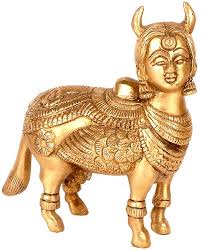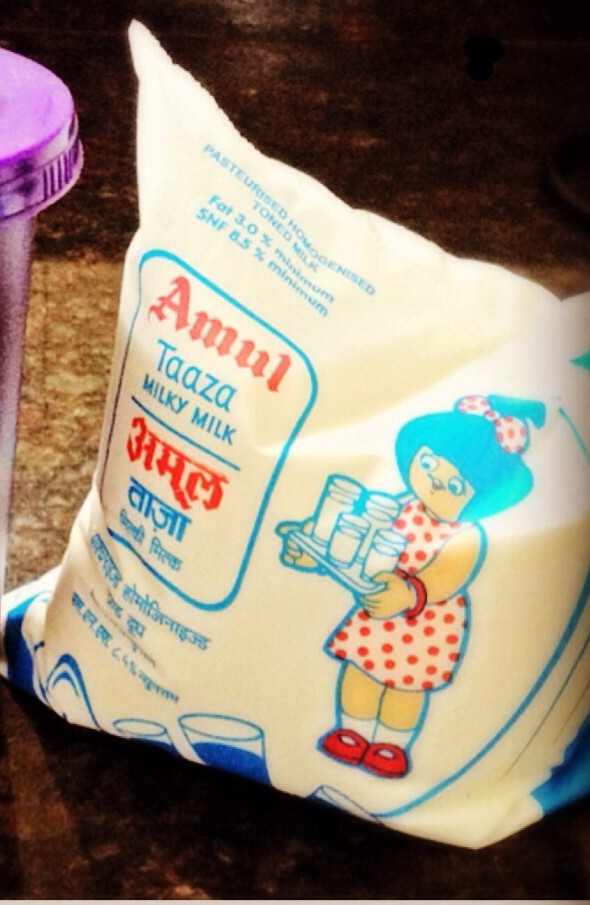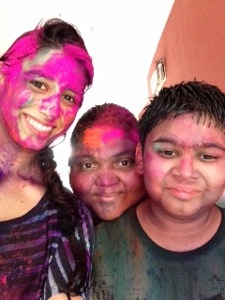#foodisbeautiful: the holy cow
In India, life would not exist without milk.
EARLY IN THE MORNING, the little trucks putter by, showering the town with a snowfall of milk packets. Every home lingers with a sweet aroma of milk bubbling and boiling on the stove. Chai doused in milk for the grown-ups. Blended Bournevita in warm milk for the little ones. A batch of homemade yogurt sets. Spattering ghee, the magic butter. Crumbling paneer and sweet milk barfi sold in slabs. Cadbury’s Dairy Milk chocolate bar, double-the-milky chocolate – I’ll be a bit bold in saying it is the only milk chocolate worth indulging in.
Things are different across the globe. In America, there is a new wave of milk alternatives – soy, rice, hemp, almond, coconut, even quinoa milk! Many people are lactose intolerant, and/or choose to avoid dairy products. I’ll admit that for a brief year in New York, I convinced myself of mild and selective lactose intolerance so that I could be a part of the trend. In retrospect, that was a bit silly for a cream baby like me.
YES, I’m part of the cream baby lineage. Granny eats condensed milk straight from the can and Mom likes to squirt cold explosions of whipped cream onto bananas and sometimes in her bran cereal (Shh!). Let’s not forget about my daily sundae diet in Berkeley when I worked at the best ice cream place in the world. Ah, that was the life.
Why does milk taste better in India? Why is it so important? Perhaps it’s because the cows are feeling so free and happy as they roam the streets like royalty. Perhaps milk has something in it that the people of India need. Perhaps the milk is a bit creamier and too irresistible to avoid. I can’t wait to dive into the Indian culture and see what this is all about!
Before we begin, I just wanted to welcome you to my #foodisbeautiful series! You can warm up to the show with my first introductory post here. If you also check out my post on Yoga Food, then you are more than ready-to-roll! AND if you just so happen to read my post on Indian customs in the kitchen, then you are on fire! Enjoy, enjoy!
—
Storytime: the holy cow.
Yes that is right, cows in India have the right to wander freely on the roads. May as well let them start voting. Indian McDonalds’ only serves chicken, and I haven’t seen beef in any shop or restaurant. How did the cows become sacred?
Kamadhenu
Goddess Kamadhenu, also known as Surabhi, is the Mother Earth herself – a symbol of Earth’s divine bounty, providing all with life-sustaining milk. In stories from Hindu mythology, the goddess manifested in the form of a cow, and was known as the “cow of plenty,” fulfilling all the wishes of the Gods and other creatures. She is not worshipped in god-form, but rather through the veneration of cows in India.
Krishna
Krishna was the infamous makhan chor butter thief! As a child, he would go stealing butter hidden in high up places from everyone’s homes. (On his birthday, all the boys in town re-inact Krishna, the “makhan chor”. Read about it here.)
Krishna was given the name Govinda or Gopala, which means “protector of the cows”. This is because he grew up as a cowherd, protecting the cows and the gopis, or milk-maids.
Ayurveda
The Upanishads and the Bhagavad Gita put fresh cow milk products on a high pedestal in Ayurvedic medicine. Fresh cow milk and ghee butter are considered the most sattvic or of purest quality foods. Ayurveda incorporates the use of milk into religious ceremonies, medicine and remedies, and as a vital, essential component of a healthy sattvic diet for spiritual growth. You can read more about this in my Yoga Food post.
The facts.
- After the US, India ranks second for milk production in the world.
- Milk in India is pasteurized, or cleaned from bacteria.
- There are no added vitamins and minerals.
- It is not homogenized, which means the milk and milk-fat have not been blended together. Instead, after boiling the milk, a layer of cream floats to the top. People usually set this aside to make butter. I like to eat it plain!
- Toned or skimmed milk available in India is the equivalent to whole milk in America, with around 3% milk fat. No wonder it tastes delicious.
The nutritional standpoint.
Dairy products are one of the main sources of protein and Vitamin D (usually found in meat products) in the typical Indian vegetarian diet. One cup of toned milk (3% fat) provides 8 grams of protein, and a significant amount of calcium and Vitamin D. Yogurt and paneer, or Indian cottage cheese, provide even more. Thus, dairy products are much too valuable to leave out of the diet!
And I think this answers my question as to why no one really knows much about veganism. They pronounce it “vay-gan” as in “Oy vey-gan”!
Ghee. This needs clarification.
Ghee is deemed most sattvic, most pure, in all of Indian mythology and yogic text. It is the first thing eaten after breaking a fast. It is one of the first foods given to a baby. Hmm, how did this high-in-saturated-fat food get its reputation?

What is it? Ghee is clarified butter. If that didn’t answer your question, clarified butter is butter with the milk solids and water removed, so that all that is left is pure, delicious, yellow, lactose-free butter-fat. It is smothered on chapattis Indian flatbread, cooked into cauliflower, roasted with sugar to make some extraordinary desserts – basically, a key ingredient in all Indian cuisine.
Healthy? Ghee is in fact, a butter, filled with saturated fat, cholesterol, and a never-ending expiration date. So it definitely requires moderation. However, you could say this ranks supreme in the world of butters. It has some pretty extraordinary benefits! Check it out:
- Ghee has a high smoke point, which means you can heat it up quite a bit, without causing it to burn and oxidize.
- Unlike many oils and butters, which sit in the stomach and slow down digestion, ghee actually helps to speed up the process of digestion by stimulating the secretion of stomach acids. Thus, we don’t feel so heavy afterwards.
- It is filled with vitamins A, D, E, and K, as well as helpful anti-oxidants.
- According to Ayurveda, ghee lubricates the organs, gives our skin vitality, helps with intelligence, and eye-sight.
Ayurvedic elixirs and remedies.
- Panchamrit – the Nectar of the Gods, a divine drink that is believed to have healing powers. It is made up of panch five ingredients: milk, yogurt, ghee, honey, sugar. Sounds like bliss.
- Kojagiri Masala Milk – A hot beverage enjoyed under the full-moon night in October, when the Goddess Lakshmi is making her rounds to all the houses. It marks the end of monsoon season. Milk is sweetened with sugar, elichi cardamom, kesar saffron, nutmeg, crushed almonds and pistachio nuts. Served warm.
- Thandai – A cold and refreshing beverage brought out at Holi, India’s festival of color and love. It marks the beginning of spring. After playing in the sun, families revive with Thandai. Milk is spiked with sugar, elichi cardamom, kesar saffron, sauf fennel, nutmeg, crushed cashew and pistachio nuts, and a dash of pepper. Served chilled.
- Cold Milk – the antacid. Milk is alkaline and quickly neutralizes the extra acid that is causing heartburn and acidity problems in the stomach. The coldness soothes any sort of burning sensation you feel from acid reflux and washes the grease down your esophagus. It is even helpful while taking painkillers, as these can irritate our intestinal wall. So next time you run out of TUMS, cold milk to the rescue!
- Warm milk – the nightcap. Boiling and heating milk breaks down the proteins, making it easier to digest in comparison to cold milk, and thus an excellent pre-bedtime snack. It’s hard to find a completely accurate reason as to why drinking milk before bed makes you sleepy. I like to think of it as if someone is tucking you in, wrapping you up in a big warm creamy blanket.
- The famous haldi-milk elixir. Turmeric, or haldi, is an incredible spice powerhouse – anti-bacterial, anti-inflammatory, immunity boosting, and so much more. This drink is an all-purpose cure – for snubbing the cold & cough before it even gets a chance to surface, to relieve and revive a tired body, to give to the kids after they have been out in the rain all day.
How to make it? Boil a little water with ginger, cardamom, turmeric, and honey for a few minutes. Add in milk and let it come to a gentle boil. Serve and enjoy right before sleeping. It works wonders.
—
So, who’s thirsty? Don’t forget to check out the handy little Indian dairy dictionary that I made for you to enjoy alongside this post.
Hope you got something out of this post, either by learning something new or reading something you already knew and then laughing because I am just discovering it now. I would LOVE your feedback. Be sure to check out the rest of my #foodisbeautiful series!
- #foodisbeautiful: the fuel. This post is the introduction to the series. It sets up the show.
- #foodisbeautiful: tuning in to the music. This post talks about naturally healthy food habits that Indians embrace to tune-in to their bodies.
- #foodisbeautiful: yoga food. This post talks a little about how yogis view food.
Much love,
More later,
SONIA





